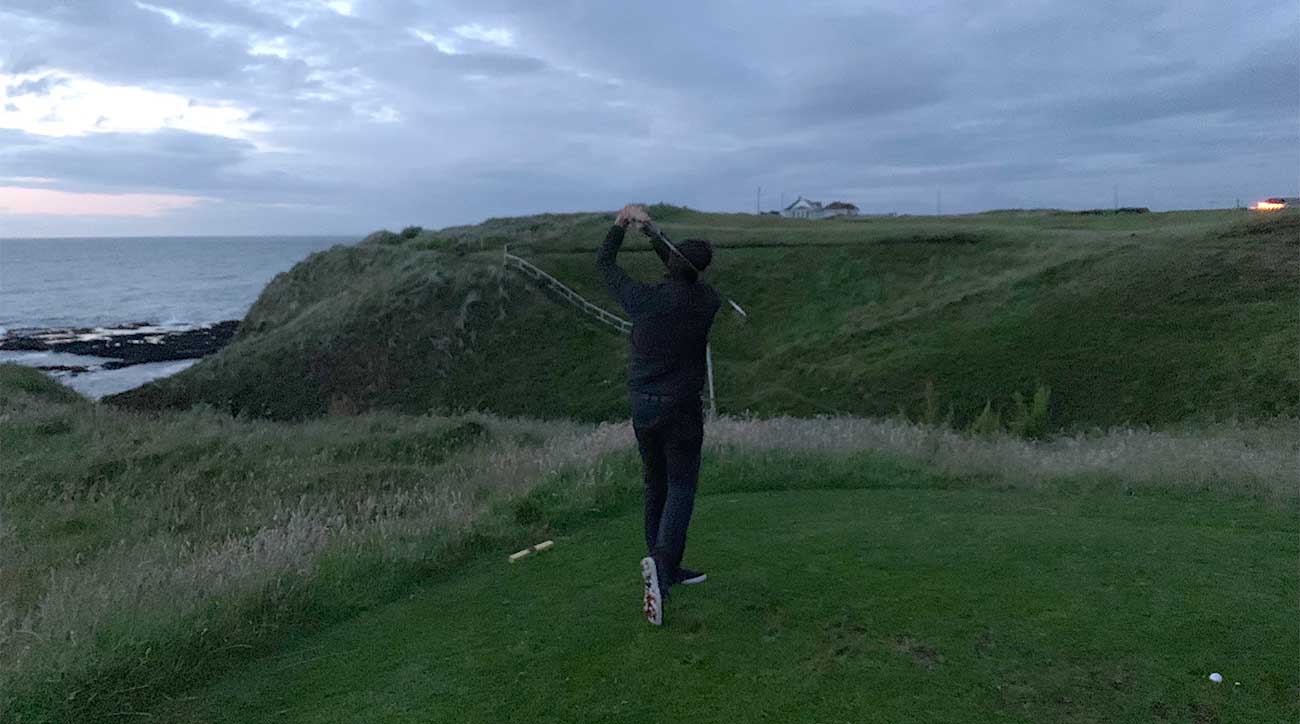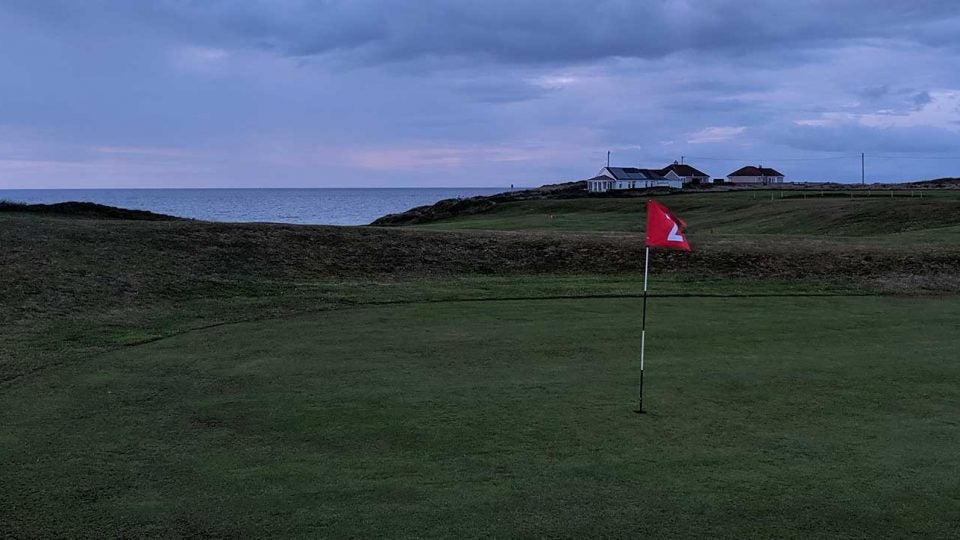Shane Lowry hoisted the Claret Jug when he won the Open Championship at Royal Portrush, Rory McIlroy put a late-afternoon surge into the crowd on Friday and Tiger Woods went home early. There was lots that went on during the 148th Open. Here’s what a few of our on-site staffers will remember most from the week in Northern Ireland.

There’s one golf course that occupies the coastline between venerated Northern Irish clubs Portstewart and Royal Portrush: Ballyreagh Golf Course. That’s where colleagues Bamberger, Shipnuck, Kerr-Dineen (Marksbury didn’t bring her clubs!) and I found ourselves late Thursday night, scrambling for a dusky few holes. But as we pulled into the near-empty parking lot at 9:20 p.m. we realized we were in for a real treat.
There are two keys to Ballyreagh: property and ethos. The first comes out of sheer luck, I guess. Craggy coastline is rather more abundant in the north of Ireland than where I’m from, but this is still a prize piece. But the ethos of Ballyreagh is what makes the place. There are two sides to the property, a pitch-and-putt and the “big course,” the latter a nine-hole par-3. Greens fees never run more then eight pounds (10 bucks), and less for juniors. There’s a practice putting green and a chipping green, there are *actual* cheap deals on used equipment and clothing in the pro shop, and there’s nary a mention of dress code on the entire property. The greens roll a strong 6 and the views are a strong 10.
The night we escaped out there, we were hardly alone. Three other groups played on in front of us, and another behind us. Three kids wheeled their pull-carts down the road on the way home. Two dog-walkers made their own fair use of the grounds. Sunset-walkers strolled the cliffside trail just below us. We set out with the goal of playing two or three holes; we ended up playing all nine, unable to resist the charm of No. 6, which played directly down at the water, or No. 7, which played directly alongside it, or No. 9, which carried a ravine, a dramatic conclusion for any golfer.
There’s no official talk of “growing the game” at the Open Championship, at least not with that sort of catchphrase. But Rory McIlroy brought it up in his pre-tournament press conference. “I’m very fortunate that I grew up here,” he said, “because golf was so accessible and you didn’t have to come from money or anything to play the game.” I came back to Ballyreagh Monday morning after the Open’s finish. Whether inspired by Shane Lowry’s win or McIlroy’s cut line charge or just unseasonably sunny weather, kids and friends and parents had flocked to both sides of the course, enjoying the best version of the game.
— Dylan Dethier

After 12 years at GOLF, I finally made it to my first Open Championship this year. I loved everything about it. Portrush is as charming in person as it looked on TV, and the course was simply divine. My husband is from Ireland, so I had some extra insider’s insight regarding the magnitude of Shane Lowry’s accomplishment. It was thrilling to watch, and while Lowry’s win will be a special one in my memory, it’s Rory McIlroy who made the biggest impression on me.
The hype for Rory’s performance at Portrush was literally years in the making. Golf is a selfish sport at its core, but it was clear from the beginning that Rory’s motivation at Portrush was more for his country — the whole island of Ireland, really — than himself. He said as much after his second round on Friday. The pressure was an enormous burden.
Willing yourself to play your best golf on a given day is practically impossible, and when Rory imploded right off the bat on Thursday, you couldn’t help but feel for him. Brandel Chamblee deemed it “choking,” and he was right. Rory knew he had one more shot at redemption on Friday, and the way he lit up the golf course in a spirited quest to make the cut was incredible to witness. Has there ever been so much excitement and energy directed at a player who was so far from the top of the leaderboard? The atmosphere was electric. It’s exactly why we love golf, and sports in general.
Rory’s raw display of emotion and class in his ultimate defeat humanized him on a new level. He became more relatable than ever, and I have even more respect for him after the way he handled himself. Lowry is the Champion Golfer of the Year, but in terms of perseverance in the face of adversity, it was McIlroy who truly triumphed.
— Jessica Marksbury

There were two people left in the Portrush press tent, as Saturday edged into Sunday, a reporter and a photographer, Keyur Khamar, from the PGA Tour. Beyond the tent’s doors, a warm rain was falling and the back-of-the-house operations at the course were in full swing, mini-trucks with play tires and inadequate headlights hauling trash and traffic cones. At the exit gate, all the human traffic was funneled into one chute and two dozen local lads, their work shifts ending and looking to let off some steam, were in there with you, bound for downtown. None of them needed the light of a cellphone. You were soaked by the time you made it to your Open-week home, but relieved. Its drying room never looked so good.
There were no hire cars (rentals) available Sunday morning anywhere near Portrush, so to make it to Esker Hills, Shane Lowry’s home club in rural Ireland, four hours to the south if you don’t make too many wrong turns, you found yourself in the front seat of an Audi taxi, with a driver you struggled to understand. A nice man, but a city driver, and he knew the country roads no better than you. He stopped for petro, for a loo visit, for a cigarette, for a map consult, wondering if he’d make it back for his evening job. The white shirt and black tie it required sat on a hanger in the back. A working man. Greater Belfast is filled with them. One of Rory’s grandfathers worked in a shipyard and the other sold ice cream from a truck.
Finally, Esker Hills came into view, the rain still falling, and it never looked so good. The clubhouse was packed and there was Keyur Khamar, making his rounds unobtrusively, lens in hand, shooting this and that. This was the other Ireland now, the sing-song Ireland the tourist boards sell. There were two boys coming off the course, hair soaked, clubs soaked, windbreakers soaked. They’d be dry in 10 minutes in the humid warmth of the clubhouse. There was a pack of girls running around the perimeter of the clubhouse. There was a boy kicking a soccer ball against a table stand. There were two young girls, conspiring silently: Let’s go to the ladies’! Their hideout. The boys would not follow them there and the grownups were all glued to the telly. Free at last.
There were 20 or 30 kids, scurrying around the clubhouse and the parking lot at Esker Hills, every last one of them wearing a team emblem of some kind. They were 6 and 8, 10 and 12, 14, and surely some odd ages, too. Shane Lowry was them, not that long ago. Keyur Khamar snapped the scenes and the kids barely knew he was there.
— Michael Bamberger
ADVERTISEMENT


